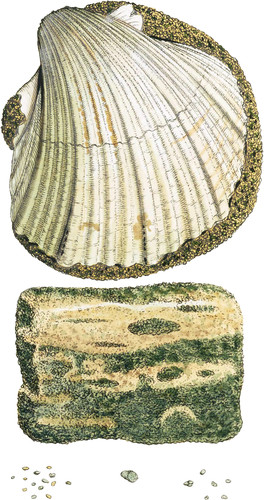 Enlarge
Enlarge
British Mineralogy
Talc
- Div. 2. Imitative, in grains.
When it is found in a state as if it had suffered a change after parting with the original rock, and with the remains of other subjects and animal exuviæ, it assumes a new appearance. Thus it is found heaped in abundance in strata that seem to have originated from the fragments of rocks, as in the sandy marle* of many parts of Somersetshire, Wiltshire, &c.
The upper specimen came from Stourhead near the seat of Sir Richard Hoare, Bart., and was picked up on that gentleman's estate by my friend Charles Mead, Esq. The shell is formed of Lime, and the sand has some fragments of Lime among it, probably more or less composed of broken shells, while the Chlorite is interspersed, forming dark green specks. The shell is curiously divided by five large ridges, between each of which are three smaller ones.
We take advantage of figuring the perfect and rare remains of this shelly as it may be of future use, perhaps, in settling some geological questions.
I gathered sand nearly of the same nature at Charlton in Kent, some years since, curiously mottled or stratified with Chlorite: see the under figure; and Woodward mentions greenish sand from Woolwich, p. 11. Lord Akamont, Dr. Clarke and Mr. Warburton have since favoured me with some sandy Lime from the Castle Hill, near Cambridge, where it is very abundant, and contains numerous petrifactions.
- * The provincial name for this is good, being Green Sand.

